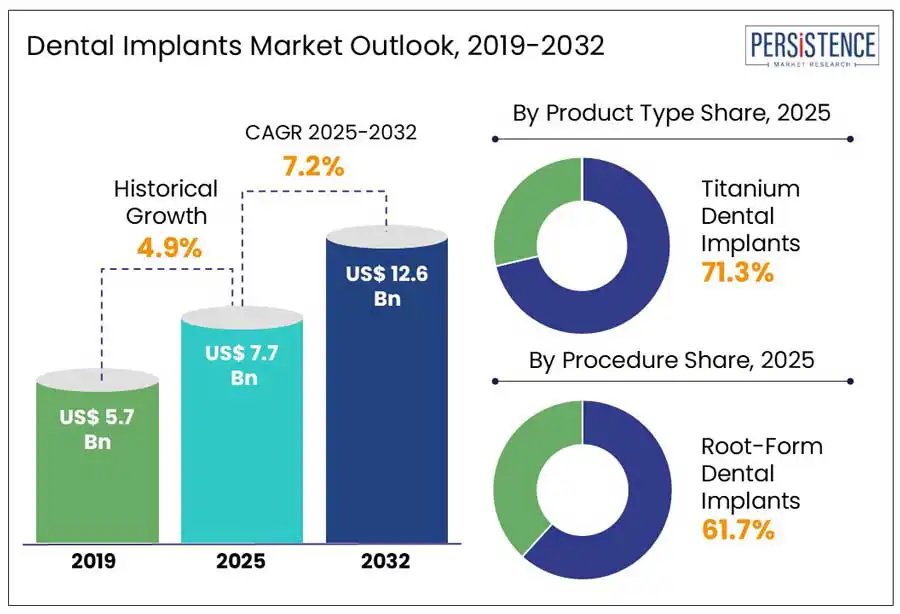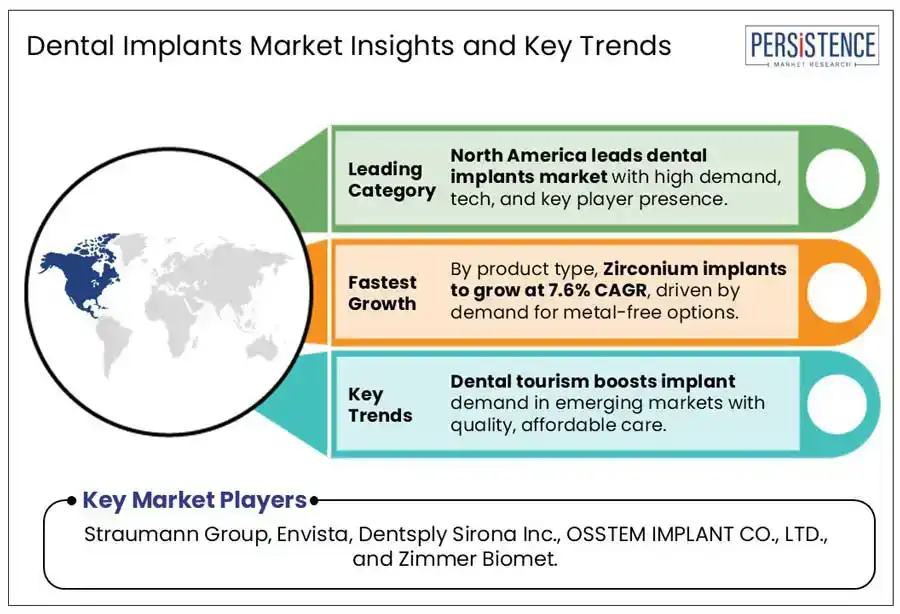ID: PMRREP2821| 189 Pages | 18 Apr 2025 | Format: PDF, Excel, PPT* | Healthcare

The global dental implants market size is anticipated to reach a value of US$7.7 billion in 2025 and will likely attain a value of US$12.6 to witness a CAGR of 7.2% by 2032.
According to the Persistence Market Research report, the dental implants market is undergoing substantial growth, primarily fueled by the rising awareness of oral health and the growing significance of restorative dental treatments. Patients are becoming more informed about the long-term benefits of dental implants over traditional dentures or bridges, such as improved comfort, functionality, and aesthetic appeal. Growing awareness coupled with a rising elderly population and a higher prevalence of tooth loss is accelerating the adoption of dental implants across various age groups.
Technological progress, including the integration of digital dentistry, CAD/CAM systems, and minimally invasive surgical techniques, is also enhancing treatment outcomes and encouraging more individuals to opt for implants. Additionally, the expansion of dental insurance coverage and the availability of cost-effective solutions in emerging markets contribute to the growing demand.

Key Industry Highlights
|
Global Market Attribute |
Key Insights |
|
Dental Implants Market Size (2025E) |
US$ 7.7 Bn |
|
Market Value Forecast (2032F) |
US$ 12.6 Bn |
|
Projected Growth (CAGR 2025 to 2032) |
7.2% |
|
Historical Market Growth (CAGR 2019 to 2024) |
4.7% |
Technological advancements have become a key driver in the growth of the dental implants market. The adoption of digital dentistry tools such as 3D imaging, CAD/CAM systems, and guided implant planning has transformed implant procedures by enabling greater accuracy, less invasive techniques, and quicker recovery for patients.
Emerging technologies such as robotic-assisted surgery, AI-driven diagnostics, and 3D-printed customized implants have further improved treatment outcomes and allowed for more tailored patient care. These innovations also help lower treatment costs by streamlining clinical workflows and reducing errors. As these technologies continue to advance and become more widely available, they are expected to significantly increase the acceptance and demand for dental implants worldwide. For instance, in 2024, Straumann introduced its Straumann® CARES® Digital Workflow, incorporating 3D imaging and CAD/CAM capabilities along with cutting-edge 3D printing for highly precise and personalized implant solutions.
Potential surgical complications and associated challenges hinder the treatment adoption. While dental implants generally have high success rates, risks such as infection, implant failure, nerve injury, and sinus issues can occur. Patients with low bone density or underlying health conditions, such as diabetes or autoimmune disorders, face increased chances of complications, often requiring additional treatments such as bone grafting or specialized implants, which adds to the procedural complexity. Moreover, the outcome heavily depends on the expertise of the dental surgeon. These factors can lead to patient hesitation and reduced adoption of dental implants, ultimately limiting market growth.
A key trend in the global dental implant market is the rising demand for antibacterial-coated implants, driven by concerns over implant durability. These coatings enhance implant longevity by protecting against harmful oral bacteria responsible for tooth decay and serious dental conditions, thereby boosting both patient outcomes and product adoption.
Various coating materials such as silica, carbon, bioactive glass, hydroxyapatite, bisphosphonates, calcium phosphates, titanium, and fluoride are being explored for use in dental surgical implants. Their porous structure, tunable particle size, and ease of surface adhesion make them ideal for improving implant performance and acceptance. For instance, in 2024, Dentsply Sirona introduced Biocoat® technology, featuring an antibacterial coating designed to improve implant efficacy. The company also emphasized integrating bioactive coatings such as calcium phosphates and fluoride-based compounds, to further strengthen both durability and anti-bacterial properties.
Based on the product, the market is classified into titanium dental implants and zirconium dental implants. Titanium dental implants dominate the market share due to their extensive use. Also, the exceptional biocompatibility of titanium with bony structures, its applicability across many treatments, and hypoallergenic properties are properties leading to the dominance of titanium dental implants.
The superior success rate and cost-effectiveness of titanium implants compared to other types enhance their application in dental treatments which is anticipated to drive market expansion throughout the forecast period. Titanium implants can be fabricated as either one-piece or two-piece systems, while zirconium implants are only one-piece systems. Two-piece implants have enhanced capabilities including the ability to sustain overdentures. Implants are produced in various dimensions (length and width), allowing selection based on patients' bone size.
Based on the end-user, the market is further divided into hospitals, ambulatory clinics, and dental clinics. Dental clinics are projected to dominate in 2025. Dental clinics frequently serve as the initial point of contact for patients pursuing tooth replacement alternatives such as dental implants. Local healthcare providers, such as clinics, can be accessed directly without hospital referrals. Clinics typically offer better scheduling and high turnaround times. Therefore, managing implant cases presents avenues for income enhancement in clinics.
Numerous entities have invested in on-site radiography, 3D imaging, and fully equipped surgical facilities to perform routine implant procedures independently. Due to their local accessibility and significantly reduced costs, dental clinics serve as highly accessible locations for patients. Implant treatment is typically administered on an outpatient basis without necessitating overnight hospitalization. The accessibility and cost-effectiveness of consultations and treatments at dental clinics has globally positioned them as a primary catalyst for implant procedures.

North America leads the dental implants market representing around 37% of the total revenue share in 2024. Regional growth is due to the increase in the elderly population with a significant prevalence of dental issues and heightened awareness among residents concerning oral preventive and restorative treatments. The American Academy of Implant Dentistry reports that three million individuals currently possess dental implants, with this figure typically exceeding that in developing nations, attributable to great resource availability, elevated per capita income, increased aesthetic concerns, and heightened awareness.
Stringent rules concerning quality standards have guaranteed the safety and reliability of dental implants which has enhanced patient confidence in dental implantology as a legitimate therapy alternative. With a growing focus on dental aesthetics, North America leads the premium market segment, with patients choosing high-quality features and materials such as titanium implants. The geriatric population pursues dental procedures owing to the increasing prevalence of tooth decay and periodontal diseases which has further propelled market expansion.
The European dental implants market is witnessing consistent growth, driven by an aging population, increased awareness of oral health, and advancements in dental technology. In 2022, there were over 363,000 practicing dentists across EU member states, with Germany leading at 71,297 dentists, followed by Italy and France.
The adoption of digital dentistry tools, such as 3D imaging and CAD/CAM systems, is enhancing the precision and efficiency of implant procedures. Additionally, the European Commission's implementation of the Medical Device Regulation (MDR) ensures higher safety and quality standards for dental implants. However, challenges persist, including high treatment costs and limited reimbursement policies, which may hinder market expansion. Despite these obstacles, the European dental implants market is poised for growth, supported by technological innovations and increasing demand for aesthetic dentistry solutions.
Asia Pacific dental implants market is witnessing rapid growth, fueled by an aging population, rising awareness of oral health, and increasing adoption of advanced dental technologies. Japan has over 104,000 registered dentists as of 2020, and well-equipped to meet the growing need for dental services.
Government initiatives, such as Malaysia's National Oral Health Strategic Plan 2022–2030, aim to enhance the accessibility and quality of oral healthcare, promoting the use of digital tools and improving workforce capacity. These strategies are crucial in encouraging the adoption of dental implants, especially as public and private healthcare providers expand their services. Additionally, the integration of CAD/CAM systems and 3D imaging across clinics in emerging markets is making implant procedures more efficient and patient-friendly. South Korea and China are also contributing significantly to regional growth, with an increased focus on affordable implants through procurement policies. These developments highlight Asia Pacific’s potential as a leading region in dental implant innovation and accessibility.
The dental implants market is highly competitive, with several key players leading innovation and shaping industry trends. Major companies such as Straumann, Dentsply Sirona, Nobel Biocare, Zimmer Biomet, and BioHorizons dominate the market, each offering a wide range of implant solutions and cutting-edge technologies. Prominent players focus on expanding their product portfolios through technological advancements such as 3D imaging, robotic surgery, and antibacterial coatings to enhance implant success rates and improve patient outcomes.
Smaller players and regional manufacturers also contribute, often differentiating themselves through cost-effective solutions or specialized offerings, such as mini-implants or customized implants. The competitive landscape is also shaped by strategic mergers, acquisitions, and partnerships, which enable companies to expand their reach and access new markets.
The global market is estimated to increase from US$ 7.7 billion in 2025 to US$ 12.6 billion in 2032.
Aging population, prevalence of tooth loss, aesthetic demand, and technological advancements drive the global dental implants market.
The market is projected to record a CAGR of 7.2% during the forecast period from 2025 to 2032.
Rise in dental tourism, preferred cosmetic procedures, and innovation in implant materials offers significant growth opportunities globally.
Straumann Group, Envista, Dentsply Sirona Inc., OSSTEM IMPLANT CO., LTD. Zimmer Biomet, and Others.
|
Report Attribute |
Details |
|
Historical Data/Actuals |
2019 - 2024 |
|
Forecast Period |
2025 - 2032 |
|
Market Analysis Units |
Value: US$ Bn, Volume: As applicable |
|
Geographical Coverage |
|
|
Segmental Coverage |
|
|
Competitive Analysis |
|
|
Report Highlights |
|
|
Customization and Pricing |
Available upon request |
By Product
By Procedure
By End-user
By Region
Delivery Timelines
For more information on this report and its delivery timelines please get in touch with our sales team.
About Author